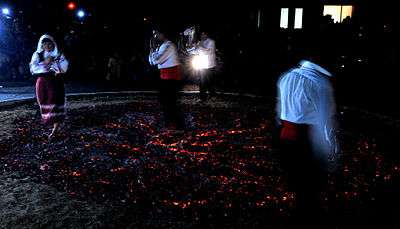Nestinarstvo

Nestinarstvo (Bulgarian: нестинарство, Greek: αναστενάρια, anastenária) is a fire ritual originally performed in several Bulgarian- and Greek-speaking villages in the Strandzha Mountains close to the Black Sea coast in the very southeast of Bulgaria.[1] It involves a barefoot dance on smouldering embers (жарава, zharava) performed by nestinari (нестинари). It is usually performed on the square of the village in front of the whole population on the day of Sts. Constantine and Helen or the day of the village's patron saint. The ritual is a unique mixture of Eastern Orthodox beliefs and older pagan traditions from the Strandzha Mountains.[2]
Nestinar tradition
Traditionally, the right to perform the ritual would be hereditary and the head nestinar may be succeeded only by his or her son or daughter, and only when he or she is too old or ill to continue performing it. The head nestinar's house is sacred, because it houses the stolnina (столнина) – a small chapel where icons of several saints are arranged, as well as a sacred drum used specifically for the ritual and believed to cure the drummer if he is ill.[3]
Description
On the day of the ritual the villagers would go to the stolnina led by the head nestinar and the priest, where they would watch him thurify the icons and the other nestinari, symbolically transferring spiritual power and inspiration to them. The people would then head to a holy spring carrying the name of the saint, where they would eat an offering of mutton.
After sunset, the crowd would build up a large fire and would dance a horo (a traditional round dance) until the fire dies and only embers remain. The Nestinari's barefoot dance on embers that follows as the climax of the night is accompanied by the beat of the sacred drum and the sound of a bagpipe. It is popularly thought that some of the dancers reach a religious state of trance while dancing, explaining why their feet don't burn and they allegedly don't feel pain.
Tourism
In the 20th and 21st century the ritual became largely commercialized and is now performed for the foreign tourists all over the seaside resorts of the Bulgarian Black Sea Coast by people who have little to do with the original tradition. A few Bulgarians still perform the ritual in its more authentic form in the villages of Strandzha.
The ritual is also preserved among the population of several villages in northern Greece, which once lived together with the Bulgarians in the interior of the Strandzha Mountains, but moved to Greece after the Balkan Wars.[4][5][6]
Honour
Nestinari Nunataks on Livingston Island in the South Shetland Islands, Antarctica is named after the Bulgarian folkloric ritual of Nestinari.
References
- ↑ Xygalatas, Dimitris, 2012. The Burning Saints. Cognition and Culture in the Fire-walking Rituals of the Anastenaria London: Equinox ISBN 9781845539764
- ↑ "Nestinari" (in Bulgarian). The Bulgarian Traditions. Retrieved 2006-08-10.
- ↑ Георгиева, Иваничка (1987). "Нестинарството в Странджа". Културно-историческо наследство на Странджа–Сакар (in Bulgarian). София: Народна младеж. OCLC 20353251.
- ↑ Xygalatas, Dimitris, 2011. “Ethnography, Historiography, and the Making of History in the Tradition of the Anastenaria”, History and Anthropology 22 (1): 57-74
- ↑
- ↑ "The fiery souls of the Anastenari". CNN. Retrieved 2010-05-20.
External links
| Wikimedia Commons has media related to Nestinarstvo. |
- Website offering detailed information about the custom and its context (Bulgarian) (English) (Spanish) (Russian) This page has been discontinued; an archived version can be seen here
- Article about the nestinari on the Bulgarian National Radio website
- Nestinari
- Anastenaria
See also
- Thèse de doctorat d'ethnologie "Essai d’anthropologie visuelle & sonore d’un "rite élémentaire" - Film de recherche "La joie du feu" - Ethnographie de la permanence d’une praxie ontologique pyrobate & de la croyance afférente en Europe orientale" Université Paris VII Denis Diderot, U.F. Anthropologie, Ethnologie et Science des Religions (AESR), n° 3604325, 12 décembre 2003, par Christine Djankoff
- Anastenaria - the Greek version of this ritual.